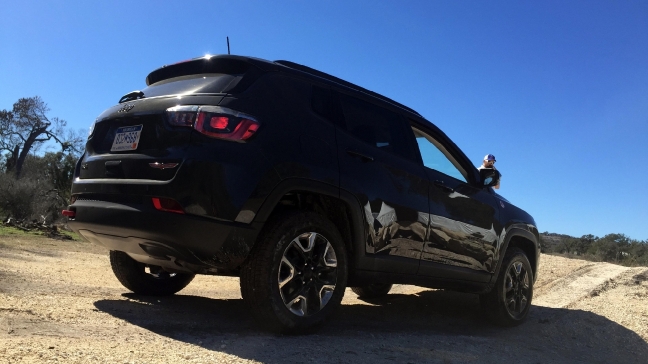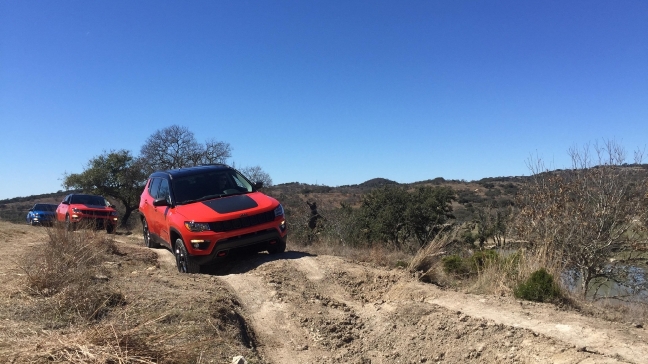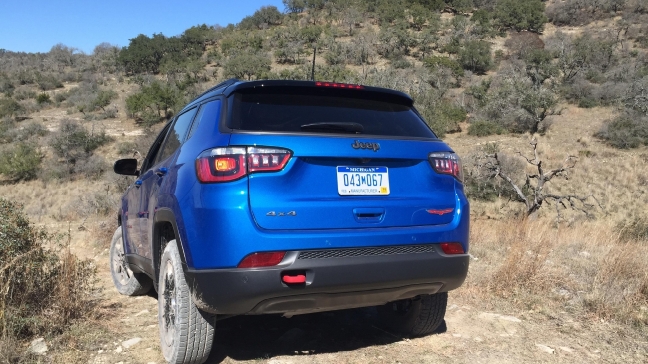2017 Jeep Compass: A competent off-roader in a compact package [First Look]
SAN ANTONIO, Texas — I’ll come right out and say it: I unequivocally did not like the previous generation Jeep Compass. I thought it looked cheap and felt woefully underpowered. Plus, it didn’t pack the off-road punch for which Jeeps are traditionally known.
So, it makes sense that the folks at Jeep would take considerable pains to showcase not only on-road handling but also off-road prowess of the all-new 2017 model during its press preview.
My first impression is largely favorable. The new Compass is pretty much everything the previous-gen was not: competent, comfortable and attractive.
At first glance, the Compass looks like a baby Grand Cherokee, and that’s on purpose. There are two design directions at Jeep: Wrangler, which is more rough and tumble, and Grand Cherokee, which is more lux-level. Compass, along with Cherokee, are slotted under the Grand Cherokee umbrella.
Strong, long lines on the exterior add an austere and elegant finish, and the silver-rimmed knobs and accent pieces within the interior give the appearance of an up-level vehicle – even in the base Sport trim. While some of the touch points are plastic, it doesn’t bother me because it looks nice, and we’re talking about a vehicle with the base price of around $22K.
The Compass has four different trim levels and pricing will range from $22,090 for a base Sport to $35,790 for a Limited loaded with every option (prices include destination). Every trim except Trailhawk, which is 4X4 only, will be available in a front- or four-wheel drive powertrain.
I had the opportunity to drive a Sport 4X2, a Trailhawk and a Limited 4X4 during the press preview. Between them, I found the Compass to be quite comfortable and attractive– whether the seats were leather or cloth.
On the highway, the Compass felt solid and quiet, holding its ground against high winds and passing semis. Some road noise does seep into the cabin, but it was neither excessive nor bothersome. We also hit some rural country roads where the compact crossover managed to remain comfortable over rough surfaces and handle curves and corners competently.
In off-road situations, Compass is a pure joy. With a 30-degree approach angle, 24-degree breakover angle and 34-degree departure angle, the Trailhawk model can handle most obstacles with relative ease. We traversed rocks and mud, steep declines on craggy surfaces and deep moguls with nary a scrape or scuff.
And, if you paid attention to your spotter, you didn’t get stuck either.
Compass is meant to be a truly global vehicle, and it will be built in four different countries and have 17 powertrain options around the world. North American vehicles will be built in Mexico and will only be available with a 2.4-liter Tigershark engine that delivers 180 horsepower and 175 pound-feet of torque. The base transmission is a 6-speed manual, and there will be two automatic transmissions available depending on whether you opt for the 4X2 or 4X4 drivetrain. The 4X2 gets a 6-speed, and the 4X4 gets a 9-speed.
I was able to test both automatic transmissions, and my personal preference leans toward the 6-speed. The 9-speed felt more like a continuously variable transmission and lacked noticeable gear shifts. When trying to pass, the tachometer would rev up to 5,000 and stick there, making the acceleration slow and sluggish. The engine might seem to work harder mated to the 6-speed, but at least I didn’t feel like I was churning through mud.
When my drive partner and I brought this up to one of the engineers, he pointed out that the 9-speed transmission weighs 120 to 150 pounds more than the 6-speed. That combined with the fact that a 4X4 drivetrain is heavier than a 4X2 could account for the perceived difference. Maybe.
What the Compass lacks in power, it makes up for in fuel economy. Each powertrain option is estimated to get 30 or more mpg on the highway:
- 2.4-liter, 6-speed manual 4X2: 23/32/26
- 2.4-liter, 6-speed manual 4X4: 22/31/25
- 2.4-liter, 6-speed automatic 4X2: 22/31/25
- 2.4-liter, 9-speed automatic 4X4: 22/30/25
What I really like about the new Compass, however, is all the available technology.
Apple CarPlay and Android Auto are available in all but the base stereo system, and Bluetooth phone pairing and backup cameras are standard across the board.
Other nice available tech includes forward collision warning, autonomous emergency braking, lane departure warning, lane keep assist, blind spot monitoring, rear cross-path detection and adaptive cruise control.
While these features aren’t available on the base Sport trim, they do become available at the Latitude level and will add about $1,735 to the bottom line because they are added as a part of packages, not singly.
Jeep considers Compass competitors to include Hyundai Tucson, Kia Sportage and Subaru Crosstrek, and I think the on-road versions of Compass stack up pretty well in terms of interior appointments, option availability and pricing.
But the off-road Trailhawk can’t be beat, and this trim is a nice option for anyone who plans to do some serious off-roading.
The new Jeep Compass is slated to hit dealers en mass by mid-April, though you might see a smattering of them at dealerships sooner than that as they start to ship from their respective plants within the next week.
Editor’s Note: Driving impressions in this “First Look” review are from an invitation-only automaker launch event that allowed special access to the vehicle and executives. Jeep covered our accommodations, meals and transportation costs.
_______________________________________
To find your next new, used or certified vehicle visit www.driveautonow.com today. Local car shopping made easy!




